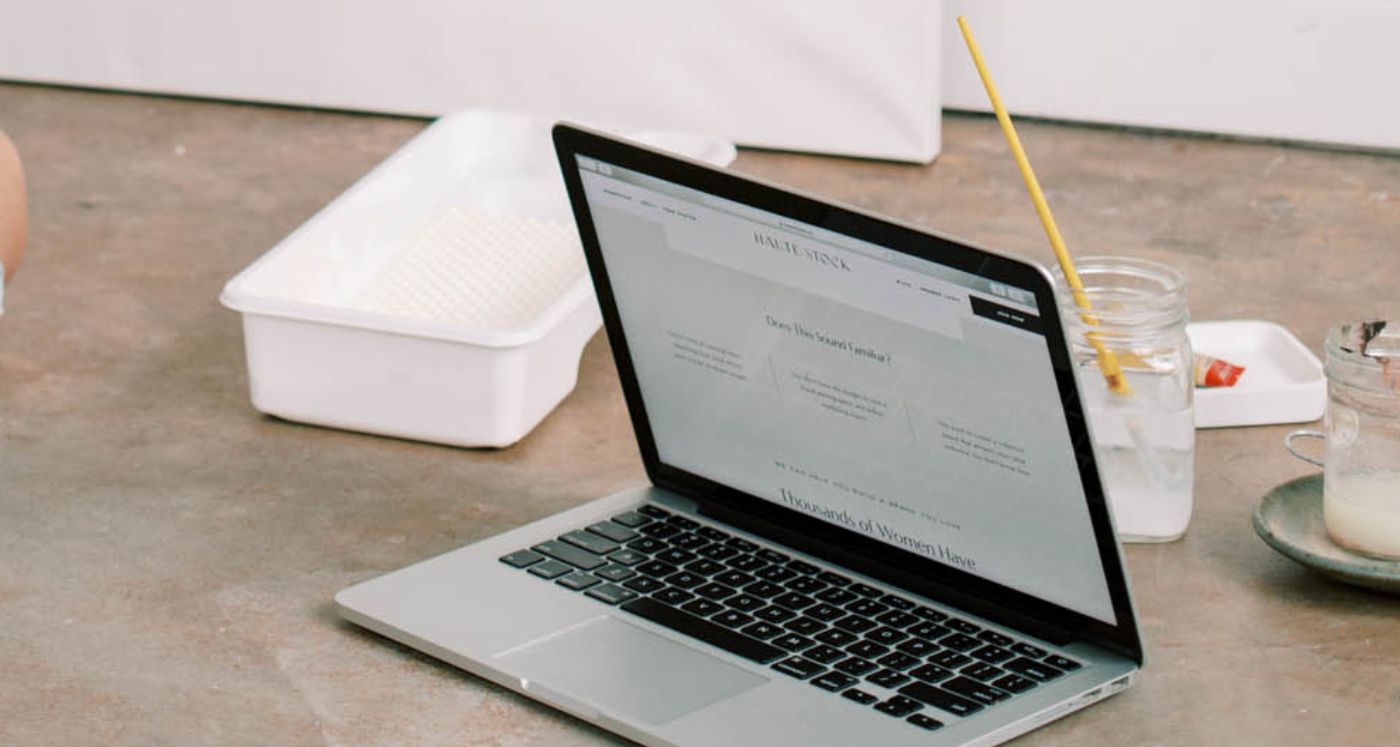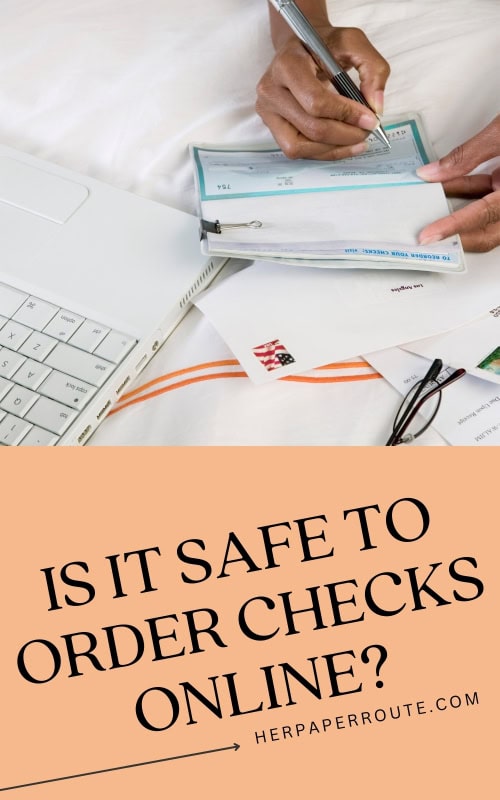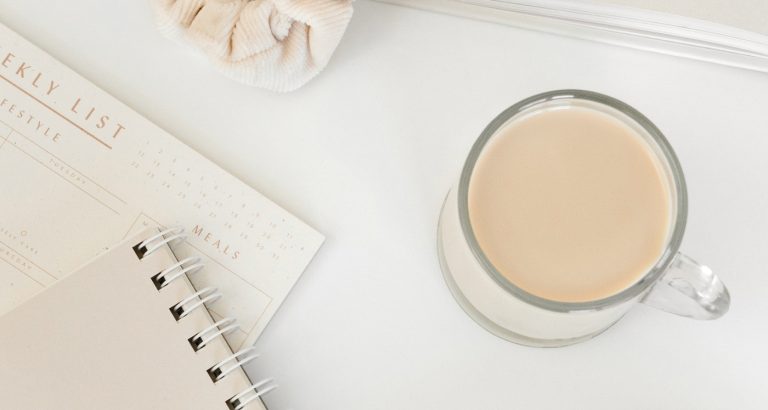Is It Safe To Order Checks Online?

Ordering checks through your bank may be innate for you at this point. What if I told you that doing so isn’t the best way to go?
It surprised me to learn this when I realized how high the cost is compared to other alternatives. It turns out that there are numerous avenues for you to order your checks online at much better rates.
As an affiliate partner of various brands and sponsored content, HerPaperRoute may earn commission on qualifying purchases. Disclaimer
It’s natural to experience some level of skepticism since everyone knows that cheaper isn’t always better. I’d even go as far as to say there are many cases in life where a lower price tag is synonymous with a reduced quality.
Thankfully, that’s not the case here, though, as it turns out there are some very stellar options that you can explore.
So is it safe to order checks online? It is safe to order checks online as long as the site has the proper security measures in place to protect your data.
It’s not all smooth sailing, though, since ordering from the wrong place can present some safety and legitimacy concerns. You need to be vigilant enough to ensure that the check company ticks all the right boxes for safety and security.
Check Safety Verification Measures To Look For
Unfortunately, more than a few unscrupulous online check sources could cause some serious trouble for you. Finding reliable ones becomes a whole process because of that, but it’s not impossible to do.
Verifying the legitimacy of checks in the ordering process requires looking for certain information and features. When you’re looking at a website to order checks from, make sure the website and checks contain the following:
MP Icon
Checks with the MP icon present give a heightened sense of security. MP is an acronym that stands for micro-printing.
In my opinion, this is one of the most genius ways to prevent check counterfeiting. It would be almost impossible to pull off, and even those who know the inner workings of MP would require precision and specialized printing equipment.
The MP inclusion uses a very small format that the human eye can’t read. Did you also know that this kind of print job is replicated on currency as well? Every bill, from the $5 and onward, uses microprinting.
CPSA Certification
The whole focus of the Check Payment Systems Association (CPSA) is to preserve the integrity and security of checks. To this end, the body is responsible for several of the standards that valid checks must meet.
A padlock icon on a check symbolizes that the CPSA’s built-in fraud protection measures are designed into the check.
I know what you may be thinking here. What if one of the less known and ethical check vendors replicate the padlock on its on check design?
Thankfully, the CPSA has a list of authorized users that you can use to cross-reference the legitimacy of the supposed accreditation in the form of the icon.
If you are not seeing the check vendor on the list, it may be in your best interest to place your order elsewhere. Before ruling out the vendor though, try to find out if there are any alternative our parent company names that the provider goes by.
That’s because the DBA (doing business as) name on the company’s website and its corporate name on the CPSA list may be different.
This is also a good time to advise you to make allowances for some third-party productions. Some companies don’t produce the checks that they sell in house.
They have partnerships or other relationships with companies that do. The result is that they have their checks made by the accredited company, which means that an authentic padlock icon would be present.
Review The Security Feature List
The microprint and padlock icons are not the only security indicators that check can have in place. A rundown of the measures that an online check provider uses can go a long way in helping you to draw informed conclusions on the legitimacy.
I found that safe sites tend to go the extra mile to let you know about what they have done to protect your safety interests.
One example of a company that does this well is Checks in the Mail. The website has a security page that details how your protection is being taken care of.
Some of the site’s measures include the padlock icon, a microprint signature line, copy protection on the back of the check, and chemically sensitive paper.
Customer Service Contact Details
Take it from me. Never underestimate the importance of reaching out to a dedicated customer service team in the event of any anomalies.
There are so many different things that can go wrong with your online check ordering process. Human and machine errors aren’t unlikely, and you must get things rectified effectively when needed.
The nature of using checks means that your concerns must be addressed in short order. That means getting through to a real person should never be a long process. I’ve noticed that the sites that fall under the less safe umbrella don’t usually have precise contact details for the customer service team.
One of the key indicators is a phone number being present. A listing of the operational hours Is another good sign that you are dealing with a reputable provider.
Secure Web Pages
Provisions for security concerns don’t start and end with the design of the check. I’ve found that you can also get context clues throughout getting to the ordering step. It begins with the moment you visit the page.
If you browse to some of your favorite well-known websites, such as YouTube or Facebook, you are likely to notice a padlock icon to the left of the text in the address bar. Additionally, the URL begins with “https.”
That’s a sign that the site uses what is known as the secure sockets layer (SSL). I won’t get into the technical specifics here, but it indicates that you are using a protected web page.
Any reputable platform that operates a website never neglects to bind an SSL certificate to the pages. Clicking on the padlock lets you know that the connection is secure, and you can even view the certifying authority (seeing the padlock is enough, so don’t worry too much about making sense of this).
Should you find an online check provider that doesn’t have the padlock icon present, there is no encryption surrounding any action you take on the site or any page you view.
What does this mean for you? Run like the wind and find another alternative.
Is It Safe to Order Checks from Costco?
Checks from Costco embody the whole third-party relationship arrangement that I discussed above. If you were supposed to look at the CPSA list of approved companies, Costco would be nowhere to be found.
Based on that absence from the list, you may start getting ready to run for the hills before some unethical or illegal activity takes place. There is no need for you to worry, as Costco simply has its checks done via Harland Clarke Check Printing.
Harland is present on the CPSA list, which is what makes checks from Costco safe to order. The fact that the company also has an incredible design variety is also a plus.
If you want to take things even further, go ahead and order Costco’s high-security checks. You get even greater fraud protection, which includes heat-reactive ink and a holographic bar.
As is the case with most things at Costco, purchases are made in bulk. You can’t order less than packs of 200 checks. The pricing is relatively inexpensive, though, as 400 high-security checks are roughly $30 for Executive Members and approximately $35 – $40 for Business or Gold Start members.
Is It Safe to Order Checks from Sam’s Club?
As far as all the security features go, Sam’s Club has all the bases covered. The site you use to get your ordering done is secured with SSL encryption, and the check design has protection as its center.
The padlock icon symbolizes CPSA’s accreditation, and there is also a microprint signature line to help prevent counterfeiting. Chemically sensitive paper is used, and the reverse side of the check has protective features built-in for your benefit.
If you’re looking to get your hands on a few checks, Sam’s Club may not be the place for you. I do recommend it to those who want to purchase their checks in bulk. It costs about $30 – $35 for 600 checks, which is a steal.
What Makes High-security Checks Worth the Cost?
While debit card fraud has a clear lead, check fraud is also incredibly common. Anything that can help mitigate its possibility warrants a second look, and high-security checks fall under that category.
The more features the check has designed into it for protective purposes, the better it is for your needs. The idea is to make modifications and copying as unlikely as possible.
Holograms, tamper-resistant paper, and microprint are just some of the design and implementation choices that come together to create a more secure experience.
Why Not Order Through the Bank?
I can’t tell you what method you should use to order your checks. I also can’t deny that ordering from your bank gives you a more convenient experience.
There is not much for you to do when you choose to go that route, but you’ll save yourself quite a bit of money by ordering checks online.
Apart from the cost benefits, the level of variety that you can get when ordering checks online rather than your bank is another incentive to look forward to. Additionally, the security features you get from online checks aren’t much different from those that the bank guarantees.
Can I Get Checks for Free?
Well, you can’t beat the price of free, right? It turns out that there are a couple of ways for you to get your hands on some free checks.
The first is to take advantage of counter checks when you run out. Your bank is willing to provide these, and you can normally get them for free. A charge comes into play when you want a larger quantity.
Alternatively, you can take advantage of promotions whenever they come up. The conditions for these tend to be very specific, and I recommend you to take advantage of them when you can if you go through a lot of checks.
What Information Do You Need To Order Online Checks?
I can’t deny that the administrative overhead is a little more complex with online checks, but the price tag makes it worthwhile. Before you can order online, there is some information that you are going to need. It is as follows:
1. Personal Contact Details
There is nothing too major here. Basic information, such as your name and address, make up the kind of information needed in this regard.
2. Bank Contact Details
The contact details for your bank are also necessary. Verify and double-check everything, which you can do from having a look at your existing checks.
3. Routing Number
This number is unique to your bank, and it’s required before you can order checks online. It’s easy to identify, as it’s a nine-digit number on the bottom left-hand side of your checks.
The routing number is important to indicate which bank is going to be paying the check.
4. Account Number
The account number of the checking account you are using is required. If you don’t readily have this available, you can look at your bank statement or in the lower area of your last set of checks.
From the left, the account number is typically the second set of numbers.
5. Check Number
This number illustrates where your checkbook is going to be starting. I’d recommend that you use a sequential organization style to make things easier for your records.
Final Remarks
Many people order their checks online instead of using their banks. The process is safe to use if you choose an online service provider that doesn’t sit on the fraudulent side of the spectrum.
Luckily, you can use a few telltale signs to give you an idea of where each check provider stands. Don’t proceed to make any orders until you feel comfortable with the security parameters in place.
Remember that you also must send in personal information for the checks to be created, so it helps to err on the side of caution.

Follow along on Instagram!










![20 Financial Self-Care Tips [You Can Start Today] 11 lighting a candle to practice some Financial Self-Care Tips](https://herpaperroute.com/wp-content/uploads/2022/04/Financial-Self-Care-Tips-768x410.png)